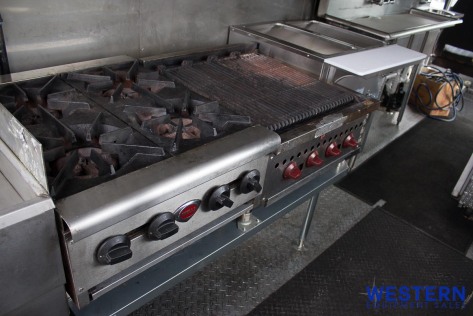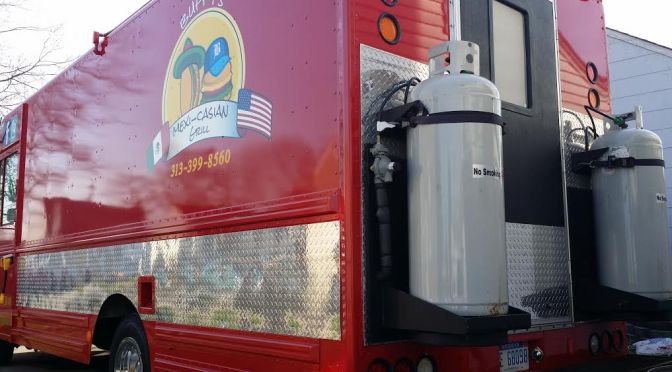Is your food truck equipment not operating properly? Do you have low gas pressure, yellow flames, a large amount of black soot deposits, and no blue flame? Your propane tank setup is probably to blame.
We recently had a customer who had a food truck built by someone else and they installed two 30 lb horizontal propane tanks in a lower storage compartment. These small tanks may work great for an RV, but a food truck and commercial cooking equipment is a different beast.
After working on our customers truck, we wanted to share some very important information about your propane system and specifically your propane tank size.
The size of your propane tank(s) DOES MATTER! It is VERY important. It is important for the following reason: The larger the tank the higher the VAPORIZATION rate of the liquid propane.
The liquid propane uses the temperature difference between it’s boiling point (-44 degree F) and the outside temperature to create vaporization. When the tank is initially filled with liquid propane (80%-85% maximum) some of the liquid vaporizes into propane gas until an equilibrium is reached. The gas is withdrawn from the tank, the pressure is lowered below that of equilibrium, lowering the boiling point of the liquid. This causes more vaporization of the liquid into gas.
Here are some things to find out when making sure you are setup properly.
#1 What is the MAXIMUM BTU’s my cooking equipment uses per hour?

Every piece of commercial gas cooking equipment is rated at so many BTU’s per hour. When you have all your burners turned up high, and are running full bore, what is the maximum demand of your equipment?
For example, a common food truck may include:
40lb Fryer – 102,000 BTU’s
24″ Broiler or griddle – 80,000 BTU’s
4 Burner Hotplate – 100,000 BTU’s
2 Well Steam Table – 7,000 BTU’s
In this example your total MAXIMUM BTU load is: 289,000 BTU’s per hour. You will need add other items that run on propane, like a propane generator.
#2 What size propane tank do I need to operate my equipment?
We understand you may never operate all of your equipment at MAX BTU’s all at the same time, but the MAX BTU will help size your propane tanks. There are a few factors that will determine the size of your tanks:
- Where will the tanks be installed on the trailer or truck? This may determine the maximum size tank you can install.
- How often do you want to have the tanks filled? If can install larger tanks or even multiple tanks this will extend the time between fill ups.
- What is the vaporization rate of the tank? Vaporization rate is the rate at which the propane liquid is boiled off to propane gas. The small the tank and the colder the temperature the lower the vaporization rate. Vaporization rate is the MOST IMPORTANT of these factors.
So in our example food truck we have 289,000 MAX BTU’s per hour.
Other things are factors too, such as ambient air temperature, and how full the tank is. The higher the temperature, the higher the pressure in the tank is, which translates to higher BTU output. Same goes for how full the tank is. Below is a good chart showing you BTU/hour based on size and outside temperatures.

As you can see, with a smaller propane tank, the max draw of BTU per hour goes down considerably. If you run two tanks in series, your BTU numbers will double to your equipment. For two 100lb propane tanks at 40 Degrees, you’ll achieve 428,000 BTU/hr. Next, lets look at total BTU capacity, which will show you how long you can run on your tanks before needing a fill up.


If you are running all your equipment for 8 hours a day at 289,000 BTU/hr, each day you’ll consume 2,312,000 in one day. That is a worst case scenario, most trucks don’t have everything running all the time, so lets say you are running at 50% max all day, your lunch rush, and dinner (if you are open for dinner). That is 1,156,000 in a day.
Two 100lb Tanks: 4,321,018 BTU Max / 1,156,000= 3.73 days before running out.
So on two 100lb tanks, you should be filling up every 3 days based on 50% of max BTU/hr consumption in order to maintain proper pressure and BTU’s needed to use your equipment correctly.
#3 What an Incorrect Setup will Do to Your Cook Line
If you are running say, one 40lb propane tank, on your best day (fill up day) you are getting 131,000 BTU/hr when it’s 60 degrees outside. If it’s winter/spring in the morning you are only getting 105,000 BTU/hr.
Equipment Needs: 289,000 BTU/Hour
Equipment Receives: 105,000 BTU/Hour
Propane Deficiency: -184,000 BTU/Hour
Your equipment may light, and may function, but you’ll experience a problem we like to call yellow flame. Yellow flame is caused by an improper air/fuel mixture resulting in yellow flame that is not as hot as the proper blue flame, and causes excessive soot and blackening of your pots and pans, and exhaust hood system.
Other side-affects of poor gas flow is increased cook times, due to your equipment trying to cook with one hand tied behind it’s back. Less BTU’s = less heat, so your equipment is operating in-efficiently.

Here is a excerpt from another blogger who addresses the issue of yellow flame. This is written assuming that your gas pressure isn’t the issue, and that it’s just your air/fuel mixture that needs adjusting:
Problem #3: Commercial Gas Broiler has a Yellow Flame or Weak Blue Flame
Commercial gas broilers should always have a strong and straight blue flame. If you notice that your broiler’s flame is flickering or has changed to a yellow color, then you need to adjust the air shutters to increase or decrease the amount of oxygen flowing to the flame.
A yellow flame on your broiler is a sign that the flame is not as hot as it needs to be. The lower-temperature flame is a problem with cooking temperatures, but it is also a problem because it causes soot to form from unburned gas. This soot will build up on your broiler’s internal parts and cause a multitude of problems.
Bottom line, it’s very important that you have proper gas flow, to make sure your equipment runs correctly. Whether you are buying a used truck, having one built, or already own one and aren’t getting the performance from your food truck equipment that you would like, this will fix your issue caused by a lack of BTU’s to your cooking equipment.
Thinking of having a food truck built in the Tri-Cities area of Washington State? We are a general contractor and would love to meet with you and give you a price on a food truck or trailer!
Western Equipment Sales
1620 E 7th Ave
Kennewick, WA 99337
http://www.westernequipmentsales.com
Open Monday – Friday 8am – 5pm PST.
866-585-6978


I may be biased because I am one of the owners of Western Equipment Sales but , this really is a darn good informational post!
Does the size of your gas line also affect your btu draw? I have 2 100lb tanks and a high pressure regulator which, when I calculated everything, should supply my cooking needs. My deep fryer soots like crazy and the flame is very yellow. When I pressure Test the fryer I only get 8″ wc, even after adjusting my regulator as high as it would go. I have 3/4″ gas lines throughout, except where they adapt down to 1/2″ to pigtail to the individual pieces of equipment. Someone recently suggested that 1″ gas lines might do the trick. I’m willing to have it rebuilt, but want to make sure I’m not wasting my time. Any advice is much appreciated. Thanks for this very informative article
Hi Jacob,
The short answer is Yes! It definitely does matter on the size of your gas line to your equipment. The BTU capacity of a 3/4″ pipe is much higher than 1/2″. Most commercial equipment has a 3/4″ connection on the back of the equipment. If you are stepping down to 1/2″ and feeding off of one T, it might be reducing your BTU’s to the equipment. You have enough tank supply provided they are full and you keep them above 1/4 full. So you either have a bad regulator, or something is incorrect in your hook up. I would recommend taking your setup to a propane gas distributor, or a local food equipment dealer who can help you diagnose the problem further. Thanks again for reading our blog!
Western Equipment Sales
Is your equipment 3/4″ in? Most commercial cooking equipment require a 3/4″ line or hose depending on the needs. A smaller gas line will definitely restrict the amount of available BTU’s. I would suggest changing out your 1/2″ to 3/4″ and see if that fixes your problem. Thanks again for commenting!
Do food trucks use vaper or liquid propane for the appliances? I see commercial cooking equipment offered in both. However it seams like vaper is what is being used throughout the truck. OR does a food truck use natral gas cooking equipment converted to propane vaper?
Hi Mark,
Equipment in our industry only operates on two gas sources, Natural Gas, and Liquid Propane (LP) which is loaded in a tank as a liquid, but turns to a gas when it warms up to temp. It is never in liquid form when its being burned, always a vapor just like natural gas. There is no way to use natural gas on a food truck. Only a brick and mortar restaurant can have natural gas. Hope this helps!
Joel
Western Equipment Sales
Your post here is absolutely awesome…. I had lots of questions and you solve all of them in one post.
Great information! Thanks.
Can you take it the next step and describe what regulator(s) are needed?
I’m running 4 appliances (2 fryers, griddle, grill) and need a total of 300k-400k of btu (still selecting equipment).
Q1: Can I attach two 100lb propane tanks in series on a 3/4″ line? Will this meet my supply requirements? (is 3/4 line large enough?)
Q2: What regulators are needed (and where)? Some people recommend a two stage at the tank. Others say put a 1st stage at each tank and a single second stage down line. Do the space/distance between the stages matter?
Q3: Some people say the horizontal tanks provide better supply. is this true? Does the horizontal tank supply change significantly depending on how full the tank is (as surface area of LP changes)?
Q4: Does the distance from the tank to the appliances reduce gas supply? Does placement of a second stage regulator effect this (i.e. if the 2nd stage is near the appliances does it help?)
additional item: If i use separate 1st and 2nd stage regulators, can I use 1/2in line between them, expand to 3/4 line after 2nd regulator? Will this still deliver 400k btu?
Additional Question:
Equipment flex line use flare fittings. Will a pipe to flare adapter reduce flow? The flare seems to have a smaller opening. To maintain the same flow as a 3/4″ pipe, should I step up to 1 inch pipe, then convert to flare and use a 1 inch flex tube, then step back down at the connection to the equipment? This would make the smallest diameter a 1 inch flare opening.